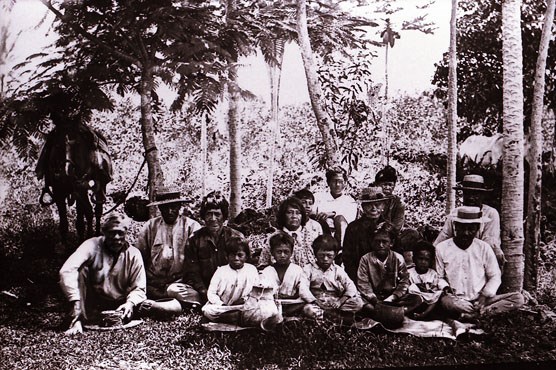
People of the IslandsSuperb voyagers, Polynesians from the Marquesas Islands were the first to settle Hawaiʻi. Estimated dates of arrival vary widely, ranging from 1700 to 800 years ago. However, the most recent carbon-dating estimates place arrival and settlement in the islands between 1000 to 1200 AD. Hawaiʻi was a highly stratified society with strictly maintained castes. The aliʻi (chiefs) headed the social pyramid and ruled over the land. Highly regarded and sometimes feared, the kahuna (professionals) were experts on religious ritual or specialists in canoe-building, herbal medicine, and healing. The maka`ainana (commoners) farmed and fished; built walls, houses, and fishponds; and paid taxes to the paramount chiefs and his chiefs. Kauwa, the lowest class, were outcasts or slaves. 
Courtesy of Lyman Museum, the Walker Collection, E.N. Hitchcock A system of laws known as kanawai enforced the social order. Certain people, places, things, and times were sacred -- they were kapu, or forbidden. Women ate apart from men and were restricted from eating pork, coconuts, bananas, or a variety of other foods. Kapu regulated fishing, planting, and the harvesting of other resources, thus ensuring their conservation. Any breaking of kapu disturbed the stability of society; the punishment often was death. Village life was rich and varied: Hawaiians fished in coastal waters and collected shellfish, seaweed, and salt along the shore. They raised pigs, dogs, and chickens and harvested sweet potatoes, taro, and other crops. Men pounded taro into poi (the staple food of Hawaiians), while women beat the inner bark of wauke (paper mulberry) into kapa (bark cloth). They worshipped akua (gods) and `aumakua (guardian spirits) and chronicled their history through oli (chant), mele (song) and hula (dance). Over several hundred years the people of Hawai`i cultivated traditions that were passed on through generations. But the sounds of taro pounding and kapa beating, rhythmical signatures of Hawaiian village life, would change dramatically after Captain James Cook arrived in 1778 and introduced the rest of the world to Hawai`i. |
Last updated: February 18, 2021
